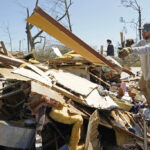As cleanup continues in the aftermath of the recent earthquake and subsequent tsunami that devastated parts of Japan, the adverse effect on the bottom line of businesses worldwide continues to be of great concern.
According to a recent study conducted by Greenwich Market Pulse, more than a quarter of large U.S. based businesses are experiencing disruptions to their supply chains or contingent business interruptions as a result of the March catastrophe.
The vast majority of large U.S. companies experiencing problems have insured against interruptions of normal operations and income; however these interruptions still pose significant risk. Questions relating to coverage and whether it applies remain a primary concern and may not be easy to answer.
Paul Sutphen, a partner at RGL Forensics, a forensic accounting and business valuation firm, after returning from a recent trip to Japan, said the primary focus continues to be personal lines claims, with commercial lines claims coming later. “These will still take time because most don’t know if they will have a claim come out of this or not,” he said.
Sutphen expects that insurers will see more claims coming through as summer sets in.
While businesses continue to work off their inventories in the months following the disaster in Japan, they cannot effectively evaluate whether they will need to file a business income loss claim.
In addition, the challenge of continuing rolling blackouts, in a country where each side of the island has power systems incompatible with the other, adds yet another layer of the unknown.
Since the earthquake, ongoing tremors have also been challenging businesses and their suppliers. Sutphen expects some customers of Japanese companies will eventually need to find alternative suppliers.
Multiple Coverages in Play
With more than 21 standard business income endorsements available, several have the potential to be triggered, including:
Gross Earnings Coverage
• Applies if the insured business has a location in Japan and suffers direct physical damage.
Contingent Business Interruption Coverage
• Applies if a direct customer’s or supplier’s property is physically damaged by covered perils specified under the policy, and causes an interruption to the business operation.
Extra Expense Coverage
• Covers additional expenses beyond normal business operations incurred as a result of a temporary shutdown.
Civil Authority Coverage
• Applies if a business location in Japan is forced to close or access to the business is prevented due to an act of civil authority.
Utility Service Interruption Coverage
• Coverage for loss due to lack of incoming electricity caused by damage from a covered peril to property away from the insured business’ premises.
Ingress/Egress Coverage
• Covers loss sustained during the period of time when, as a direct result of a peril not excluded, ingress or egress from real and personal property located in Japan is denied.
Dependent Property Coverage
• Provides coverage in connection with damage to contributing locations that a business is dependent on for material or services.
Coverage Questions Loom
While business owners may have one or more of these policy options, they may be unsure of the exact coverage afforded to them as a result of the disaster in Japan. Sutphen points out that business owners may not be aware that earthquake and/or flood insurance must also be in place in order for some of the above listed policy provisions to apply,
“The business needs to have coverage of the same kind as the supplier who sustained damage. For instance, if a parts supplier in Japan suffered flood damage in Japan, flood coverage would apply,” Sutphen said.
Some coverage questions may be easier to answer than others. Insurers have already told Sutphen that they will not cover the power reductions that occurred after the earthquake and tsunami because those were planned outages.
Lorie Masters, a partner with the law firm of Jenner Block, agrees that it will take more time for everything to shake out. The valuation provision alone can be very complicated, requiring record collection and utilization of outside resources including accountants and consultants to evaluate potential business income claims.
Large catastrophic losses tend to be eye-opening for businesses that cannot access documents or that poorly manage documentation. Three-quarters of the businesses surveyed in the Greenwich study lack coverage providing protection in the event that they cannot access records, documents and reports needed to assess the extent of claims. Masters cites the Gulf oil spill as an example. In the aftermath, many businesses realized they did not keep adequate documentation of expenses or loss of income to support their claims.
The time it takes to sort through a business income claim is another important factor. Generally, the law permits an insured to give notice of a claim within a reasonable time period.
“The question is, what is reasonable?” asks Masters.
The policy, too, will delineate time requirements within the conditions and notice. These may be affected by applicable state law. Then there is the proof of loss requirement and suit limitation provision which can both act as a contractual statute of limitations.
The long term impact of the catastrophe in Japan on businesses around the world remains unknown. Masters says there will be considerable “gray areas” that arise from business income claims. There will be questions relating to the definitions of terms within the policy forms, such as what defines a “supplier.”
“Disputes will likely arise from real coverage issues; whether or how it applies to the claim, what does customer mean, does it include the end user or some other company along the supply chain,” says Masters.
Another important question is whether there is a limit to how many suppliers can be within a supply chain, given the fact that many products are made up of multiple components.
Then there is the question of the nuclear exclusion contained within most policies. The Greenwich study found that 70 percent of businesses have no specific coverage protection against issues related to nuclear contamination. Masters says there isn’t much case law on the exclusion and whether it will apply.
Yet another question arises out of concurrent causation and the coverage ramifications, if more than one covered peril or excluded peril combined to make the loss.
In the end, it may take a long time before there is resolution on many of the business income claims spawned from business interruption as a result of the March earthquake and tsunami in Japan.
“The scope of losses may be large enough that insurers will want to test the limits of coverage,” said Masters.
Was this article valuable?
Here are more articles you may enjoy.

 Death Toll Rises From Tornadoes, Wildfires and Storms in Multiple States
Death Toll Rises From Tornadoes, Wildfires and Storms in Multiple States  A True Alternative to Opioids for Workers’ Comp? Questions Remain
A True Alternative to Opioids for Workers’ Comp? Questions Remain  AAA Study Shows Consuming Cannabis and Driving The Same Day is Common
AAA Study Shows Consuming Cannabis and Driving The Same Day is Common  Citigroup Sued by More Ex-Sales Traders Over 2019 HK Firing
Citigroup Sued by More Ex-Sales Traders Over 2019 HK Firing 